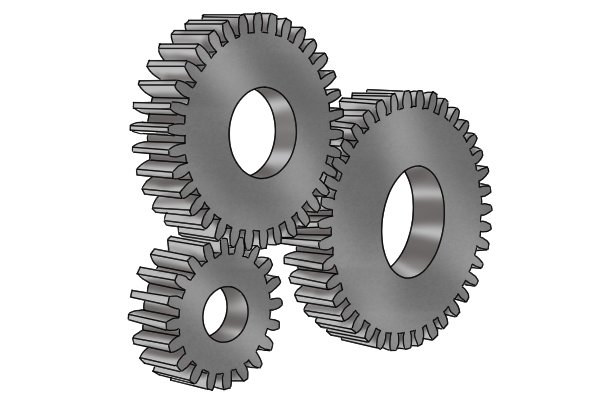Gears

This session is based on short question answer types question banks, which improves your conceptual knowledge about various factors such as classification, types, importance pros and cons etc. This session will cover basic information about types of gears and its manufacturing process.
Gear is a transmission element ,where it transfers power,torque from one point to another in the transmission line. Gears are commonly used in for transmitting torque,power from engine in all types of automobiles(but some uses belt drives),industries e.t.c.
These are used when power input system and the power output system are close to each other.Gears transmits the power,torque at constant speed ratio when it meshes with another gear. This constant speed ratio depends on ratios of the radius of the gears .
These are used when power input system and the power output system are close to each other.Gears transmits the power,torque at constant speed ratio when it meshes with another gear. This constant speed ratio depends on ratios of the radius of the gears .
Answer.
- Spur gears
- Helical gears
- Double helical gears
- Herringbone gears
- Spur rack and pinion
- Bevel gears
- Worm gears.
Q.2. Explain casting process for the manufacturing of gears.
Answer.
Dry sand casting, permanent mould casting, shell moulding, plastic moulding and lost wax process are generally used for the casting gears.
Casting of gears is same as casting of other products. Heavy gears of cast iron and steel are produced by sand casting. Gears produced by this method have poor surface finish and accuracy.
Small sized zinc base alloy gears are produced by die casting. Such gears are suitable for transmission of light load only.
Casting is the cheapest method of production and is suitable where economy is the main criterion. Die casting is preferred for the production of a large quantity of small gears of non-ferrous materials.
Q.3. Explain stamping process for the manufacturing of gears.
Answer.
This method is suitable for making gears from sheet metal upto a thickness of 3mm. In this process, stamping is done by placing the sheet on the stamping die and punching with the help of a power press.
Gears used in watches, household gadgets, clocks, toys etc. are produced by this method. After stamping, the shaving of gears is done to improve accuracy and surface finish. Very little material is removed in this process.
Q.4. Explain stamping process for the manufacturing of gears.
Answer.
This is the method of forcing a master gear of the required profile and module into a hot blank and then rolling the two pieces together until the master gears penetrates to form a complete gear. Finally , the teeth are finished accurately by finishing.
Q,5. Explain powder metallurgy process for the manufacturing of gears.
Answer.
This the process of making gears from metallic powder by the application of heat and pressure with suitable binder. This method is suitable for making gears from materials difficult to cast or machined. Pump rotors and gears used in the automobile industries are produced by this process. Powdered pure iron is mixed with a calculated amount of graphite powder, pressed in die and then heated to get gear of the required dimensions. This gear is then impregnated with oil to reduce wear, tear and noise.
Q.6. Explain extruding process for the manufacturing of gears.
Answer.
This process is suitable for making gears of aluminium, zinc and their alloys. In this process, the heated material to be extruded is placed inside the cylinder and pressed from one end with a ram. The other end contains a die resembling the shape of gear. On pressing, the gear shaped material comes out of die. The extruded gear is then hack-sawed and finally finished to size. This method is used to manufacture spur gear only.
Q.7. Write the advantages of hobbing.
Answer.
- It gives a high rate of production.
- It is rapid and economical and high degree of accuracy can be maintained on the products over a large period.
- This method is suitable for large and medium batch productions of all shapes.
- Long shafts and splines can be easily accommodated on hobbing machines.
- Control over tooth spacing, lead and tooth profile is easier.
- All types of spur and helical gears can be cut on metals and non-metals.
- A large number of similar gears held on a mandrel can be cut at a time.
- Gap type herringbone gears can be generated only through this process.
Q.8. Write the advantages of gear shaping.
Answer.
Some of the main advantages of gear shaping are as follows:
- It can be used for cutting spur gears, helical gears, racks, splines and many others.
- Internal gears can be cut at fast rate.
- One cutter can be used for all gears of the same pitch.
- It can also cut gear upto a shoulder when only a slight recess has been provided.
- Some non-conventional types of gears such as elliptical gears, duster gears, face gears can only be cut by gear shaping.
- It is suitable for medium and large batch production.
Coming Soon!
We are trying our best for it. We have engaged all our resources to get notes uploaded as soon as possible. We will update this page as soon as notes are available to upload.

No comments:
Post a Comment